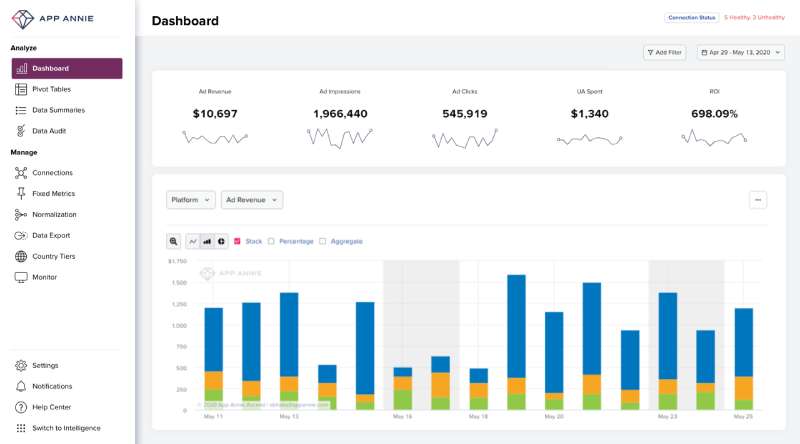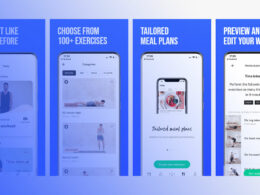Imagine your app—a brainchild crafted from months of coding, design tweaks, and bursts of late-night inspiration—poised on the precipice of public acclaim, yet invisible. It’s buried beneath an avalanche of digital offerings in the app store.
The app store ranking algorithm is your sherpa here, the silent force that can either propel your app to the peak of visibility or leave it obscured in the vast app wilderness.
In an era where app discoverability is tantamount to success, understanding this enigmatic algorithm is not just advisable—it’s critical.
By the article’s end, expect to navigate the App Store Optimization terrain with newfound confidence—poised not just to compete, but to dominate.
You’ll acclimatize to ranking signals, wield the power of user engagement metrics, and master conversion rate optimization. Let’s demystify the hidden leviathan: the app store ranking algorithm.
Keyword Optimization Strategies
The Role of Keywords in ASO
It’s like a secret sauce, those words you choose to describe your app, affecting its destiny in the crowded app store marketplace.
Keywords are critical; think of them as beacons that guide users right to your virtual doorstep.
Importance of keyword selection cannot be understated. Pick the right words, and you’re visible.
Choose poorly, and you can wave goodbye to those potential users.
With keyword placement strategies, it’s all about location, location, location.
Slip in keywords where they count: in your app’s name, subtitle, and even throughout the description. It’s like hiding Easter eggs in plain sight.
Tools for Keyword Research
| Keyword Research Tools | Keyword Tracking | Competitor Analysis | Keyword Suggestion | Additional Features |
|---|---|---|---|---|
| App Annie | Yes | Yes | Yes | Market intelligence, Usage analytics |
| ASOdesk | Yes | Yes | Yes | Organic Report, Keyword Auto-Suggestions |
| Mobile Action | Yes | Yes | Yes | Market insights, Search Ads Intelligence |
| AppTweak | Yes | Yes | Yes | Review & ratings analysis, App Power |
| App Radar | Yes | Yes | Yes | Store listing optimization, App Management |
| AppFollow | Yes | Yes | Yes | Review & ratings monitoring, Slack & email integration |
App Annie
Imagine diving into the app market with a treasure map, one that charts the seas of app downloads, revenue, and user engagement with impressive precision. That’s App Annie for you—an insightful compass in the tempest of app store optimization. It equips you with market data analysis tools to hone your competitive edge.
- Market trends analysis
- User demographics reporting
- App revenue and download tracking
The crown jewel here? Market intelligence. With App Annie, it’s like having an inside scoop on global app store rankings, knowing precisely how an app’s visibility aligns with market trends.
ASOdesk
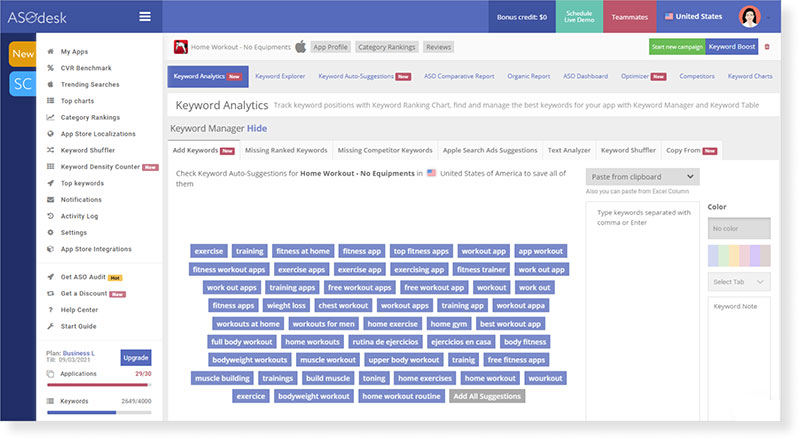
Unlock the realm of organic app growth with ASOdesk—a knight in shining armor for your app store prominence. It specializes in keyword visibility and optimization, ensuring your app doesn’t play hide and seek with potential users.
- Organic user acquisition
- Keyword tracking and suggestions
- Competitor analysis
ASOdesk’s keyword suggestion engine truly sparkles. It serves as your personal soothsayer, predicting which terms could catapult your app into the limelight.
Mobile Action
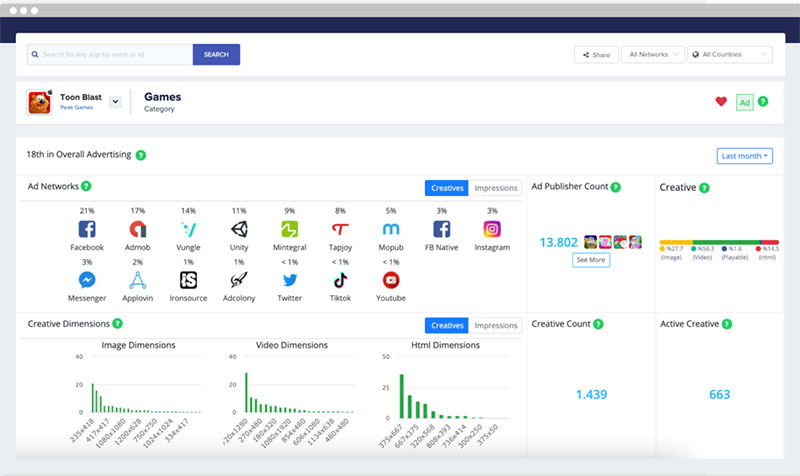
Mobile Action is the alchemist’s lab where app store magic happens. Take the raw elements of download rate, user reviews, and retention rates, and transmute them into gold—actions that lift your app’s store ranking.
- ASO Intelligence
- Review and sentiment analysis
- User acquisition reports
Its ASO Intelligence feature glows the brightest. Imagine having a crystal ball that reveals the secrets of App Store Optimization, guiding your app to the summit of app store search results.
AppTweak
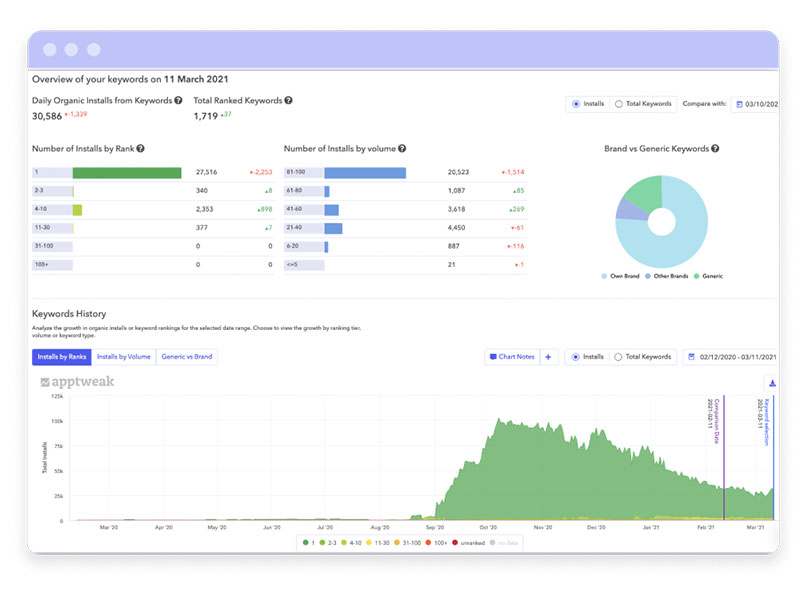
AppTweak whispers in your ear the mantras of powerful ASO tactics. With user experience and behavior analysis at your fingertips, it’s like having an oracle foresee how your app resonates with its audience.
- Keyword impact measurements
- A/B testing for app metadata
- Localization recommendations
The A/B testing capabilities shine radiantly here. You get to experiment with creativity—adjusting app titles, descriptions, and visuals—to enchant users into clicking ‘install’.
App Radar
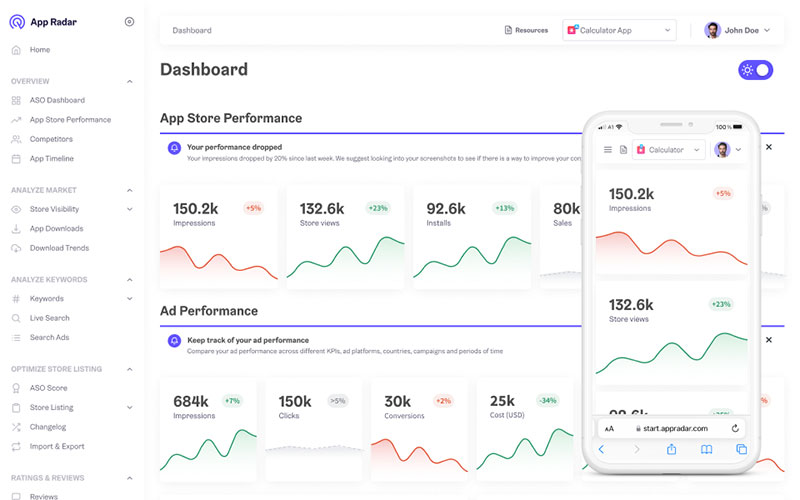
With App Radar, you become the commander-in-chief of your app’s destiny. Steer through the rough seas of app store algorithms with tools crafted for pinpointing the most strategic keywords and tracking app performance meticulously.
- ASO Keyword monitoring
- App update management
- Integration with app store consoles
App Radar’s integration with app store consoles is its star feature. It streamlines update management, acting like a bridge between your app’s on-ground performance and the tactical maneuvers you plan next.
AppFollow
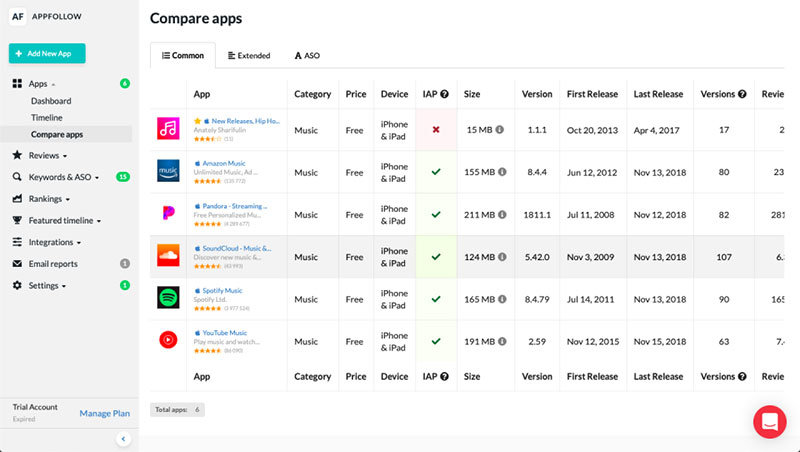
AppFollow gifts you an eagle’s eye view over user feedback and support, a cornerstone in nurturing app store ranking and reputation. It emphasizes on embracing user reviews and ratings as valuable data for steering improvements.
- User feedback aggregation
- Workflow and team coordination
- Search result analysis
The seamless aggregation of user feedback is AppFollow’s tour de force. It places the voice of your users front and center, framing it as the lighthouse guiding your app towards greater satisfaction and, consequently, higher rankings.
Implementing Keywords in App Metadata
App title and subtitle optimization can seem like a tightrope act. You need to balance catchy with clear, all while hitting those keyword targets.
Remember, it’s the first thing users see; make those words count.
Then, it’s onto the meat of it. The app description is where you tell your app’s story, and description and keyword field best practices dictate it’s also where keywords feel at home.
But don’t stuff them in like sardines. Weave them through naturally, like threads in fabric.
Risks and Rewards of Keyword Optimization
Sure, keywords can be your best friends, but they can also turn on you. Over-optimization penalties are real.
Jam too many keywords into too small a space, and boom, you’re labeled a spammer. The app store ranking algorithm is smart, getting smarter, and it has no patience for keyword-stuffers.
Conversion Rate Optimization (CRO)
Importance of High Conversion Rates
So, here’s the deal with conversion rates: they’re like applause at the end of a show. The louder the claps, the more you know you’ve nailed it.
High conversion rates mean more folks not just peeking at your app but actually downloading it.
This has major kudos with the app store ranking algorithm, which is always eyeing who’s getting the most attention.
And it’s a domino effect. Better conversion rates lead to better visibility, which invites even more users into the mix.
It’s the app equivalent of a packed house at a concert, everyone’s there because they heard it’s the place to be.
Enhancing Visual Assets for Better Conversion
It’s a visual world. A kickass app icon is your foot in the door, the first thing people see. It’s got to be love at first sight.
Designing compelling app icons is about melding art with purpose, grabbing interest in a split second.
Visual storytelling doesn’t stop there. Creating engaging screenshots and videos is painting the picture of an experience.
It’s that peek inside that makes someone think, “Yeah, this looks like a ride I wanna take.”
Optimizing App Store Pages for Higher Engagement
Now for the wordsmithing part. Crafting compelling app descriptions is like telling a good story.
Every word should draw people in, make them feel at home, and most importantly – make them stay.
Let’s not forget the chorus of voices that come from effective use of reviews and ratings. People trust other people.
Good talk about your app can convince fence-sitters to hit download. It’s all about showcasing those five-star experiences.
Analyzing Conversion Rates and A/B Testing
You’ve got tools at your disposal, don’t be afraid to use ’em.
Tools for conversion rate analysis are your spies, letting you in on what works and what doesn’t. Use them to catch the beat of how your app performs in the wild.
Managing Reviews and Ratings
The Impact of User Feedback on Rankings
Here’s the scoop: what people say about your app, it’s like a megaphone to the world—and to the app store ranking algorithm.
Those little stars and comments? They’re powerful. They whisper to the algorithm, “Hey, this app’s hot” or “Nah, not so much.” It’s all part of the game.
And it’s a double whammy. Not only do these ratings and reviews nudge the algorithm, but they also build trust with other humans.
Folks looking for apps lean on these ratings. It’s the good ol’ word-of-mouth in digital form.
Strategies for Accumulating Positive Reviews
Alright, we all want stars, the more, the brighter. Best practices for soliciting reviews from users—it’s about timing and tact.
Ask users when they’re feeling good about the app, like after a win if it’s a game or after they’ve just nailed a task.
But sometimes, you gotta take the bitter with the sweet. Handling negative feedback, it’s an art.
One bad review can feel like a slap, but respond right, and it’s turned around. It’s about showing you care, that you’re on it, fixing things up.
Monitoring and Responding to Reviews
Now, how do you keep an eye on what folks are saying? With tools for review monitoring. They’re your ears on the ground, catching every whisper, every shout about your app.
Enhancing User Retention and Engagement
Significance of User Retention in ASO

Okay, so think about user retention as your app’s backbone. It’s that critical.
Why?
Because the more people stick around, the happier the app store ranking algorithm is.
There’s this thing called correlation between retention rates and app rankings.
It’s like a mutual crush—the better your retention, the higher you rank, the higher you rank, the better your retention. And isn’t that just a sweet cycle?
But, how do you keep tabs on who’s staying and who’s straying? That’s where strategies for measuring and improving retention come into play.
It’s crunching numbers, understanding trends, and tweaking your game plan to make your app stickier than a pot of honey.
Features and Updates to Boost Engagement
Now, you wouldn’t wear the same outfit every day, right? Same goes for your app. Regular updates keep things fresh.
The role of app updates in user retention? Huge. Each update is a reason for users to fall back in love with your app all over again.
Let’s chat about the thrill of the new. Implementing features that enhance user engagement, it’s like throwing a killer surprise party.
Users dig surprises—they keep them intrigued, delighted, and most importantly, engaged.
The Risks of Neglecting User Engagement
But hey, let’s flip the coin for a sec. Ignoring user engagement? Big oops. The potential impact on app store rankings is like driving with the handbrake on.
Your app’s going nowhere but down.
Technical Performance and Its Influence
App Quality and Performance Optimization
Truth be told, nothing screams “top-tier” like an app that’s smooth as butter. The app store ranking algorithm? It’s got a soft spot for technical excellence.
Imagine your app as a race car—performance is what gets you past that checkered flag first. That’s the Importance of technical excellence in ASO.
When rubber meets the road, common technical issues like slow load times or clunky navigation can throw a wrench in the works.
You gotta have your tools ready, fine-tune and tweak, because when your app purrs, users notice, and so does the app store.
Regular Updates and Maintenance
Listen up, keeping an app fresh isn’t a “set it and forget it” deal. It’s an ongoing conversation with users. The frequency and timing of app updates matter.
Time them right—like after squashing a pesky bug or when you roll out a shiny new feature, and you’re golden.
And talking about what’s new, it’s all about the hype. Engaging users with update logs and feature announcements turns a regular update into a celebration.
It’s not just maintenance; it’s a continuous upgrade to the user experience.
The Impact of App Crashes and Bugs
Oh boy, now if there’s a party pooper in app world, it’s crashes and bugs. They don’t just annoy users; they throw shade at your app’s rep.
And yeah, you guessed it, how technical failures affect app rankings is not pretty. Too many crashes and the app store thinks you’re not the cool kid anymore.
Localization and Global Market Strategies
The Role of Localization in ASO

So, here’s the scene: the world’s a big place, tons of people, loads of languages. You want your app to be a global hit, right?
Well, that’s where the power of localization comes into play. We’re talking about tailoring your app to feel like home, no matter where home is. Benefits of app localization for global reach? Huge. It can skyrocket downloads because folks everywhere dig it when things speak their language.
Let’s chew on this – it’s not just words; it’s the whole vibe. Cultural considerations and market-specific customizations matter.
It’s showing respect, getting local nuances just right. It’s making sure your app doesn’t just translate, but transcends.
Implementing Effective Localization Strategies
Alright, time to get hands-on. Choosing where to make your mark, it’s like picking where to open a new coffee shop.
Researching and selecting target markets is step numero uno. You look for spots thirsty for what you’re brewing.
Then it’s down to the nitty-gritty. Localizing app metadata, visuals, and functionality – it’s like outfitting that coffee shop so locals say, “Yup, this is the spot”.
It’s about fine-tuning every bit and bob so it feels just right.
Risks and Challenges of Localization
It ain’t all smooth sailing, though. Localizing’s tricky business.
Potential pitfalls in translation and cultural adaptation, they’re out there, lurking like hidden rocks ready to bash your boat. A wrong word here, an odd image there, and wham, you’re off course.
FAQ On App Store Ranking Algorithm
What factors does the app store ranking algorithm consider?
The algorithm’s kinda finicky, y’know? It looks at a bunch of stuff.
Keywords in your app description, user reviews and ratings, download and install counts, and even user engagement like retention. Oh, and updates – keep your app fresh and the algorithm digs that.
How often should I update my app to maintain a good ranking?
Regular updates keep your app in the algorithm’s good graces. Think periodical – every few weeks or months.
It’s about fixing bugs, rolling out features, and just showing you’re active. Don’t overdo it; just keep the pace steady and meaningful.
Do user reviews and ratings significantly impact my app’s ranking?
You bet they do. Think of user reviews and ratings like a crowd cheering. The louder and more enthusiastic, the better the show, or in this case, the better your app’s visibility. Both quantity and quality are huge, so encourage that feedback loop.
Is it important to localize my app for different regions?
Totally. Imagine someone finding your app and it feels like it was made just for them, wherever they are. That helps with your ranking because it boosts downloads and user satisfaction. It’s like giving the world a personal handshake – powerful stuff.
What role does app store optimization (ASO) play in improving rankings?
ASO’s a major player. It’s the process of fine-tuning your app so it’s more attractive to the app store algorithm. Nail your keywords, descriptions, and visuals. It’s like SEO but for the app store. Get it right, and you’ll climb those ranks.
How does the number of downloads affect app store rankings?
It’s huge. More downloads are like a thumbs-up to the algorithm. It’s social proof, telling the app store, “Hey, people dig this app.” But remember, sneaky tactics won’t fly; it’s all about genuine growth.
Can influencing user engagement improve my app’s ranking?
Engagement is key. Get users hooked, and keep them coming back. The more they play around with your app, the more the algorithm thinks you’ve got something hot. It’s the quality of user interaction that counts here.
How critical are backlinks to my app’s store page for its ranking?
Backlinks are more about getting direct traffic to your page than influencing app store ranks. But hey, more traffic, more potential downloads, and that’s what the ranking game all boils down to eventually.
Will changing my app’s name or title affect my ranking?
Oh, absolutely. Your app’s name is like a first impression. Make it relevant and keyword-smart, and you could see a ranking bump. But don’t go overboard with changes; consistency matters too. Balance is the name of the game.
What impact does app store compliance have on my app’s ranking?
Staying on the right side of app store guidelines is paramount. Slip up, and you might just face a penalty, which can drop your rank like a hot potato. Play by the rules for smooth sailing.
Conclusion
So we’ve dived deep, haven’t we? The app store ranking algorithm — sounds almost mythical. But now, it’s a bit less of a black box and more like a puzzle we’re piecing together.
We’ve explored ASO fundamentals, keyword optimization, and the inner workings of user feedback and engagement.
The take-home is clear:
- Stay sharp with your keyword choices and where they live in your app’s metadata.
- Keep a keen eye on those user reviews and ratings; they’re more than just stars—they’re your navigation stars.
- And don’t forget to treat your users right. Regular updates demonstrate your commitment to quality and user experience.
Let’s wrap this up with a simple truth: understanding the app store ranking algorithm isn’t just about cracking a code—it’s about making your app the best it can be. And hey, the better your app, the more those algorithms and users will notice. Just keep it real, focused, and always, always user-first.
If you liked this article about the app store ranking algorithm, you should check out this article about app subtitles.
There are also similar articles discussing mobile apps KPIs, Android app store optimization, ASO A/B testing, and app store keyword search volume.
And let’s not forget about articles on app keyword research, game ASO, Google Play store ranking algorithm, and Google Play store screenshot sizes.
- Professional Video: Cinematography Apps Like FiLMiC Pro - April 26, 2024
- Optimizing Your Shopify Store for Maximum Dropshipping Success - April 26, 2024
- Python Explained: What is Python Used For? - April 26, 2024






